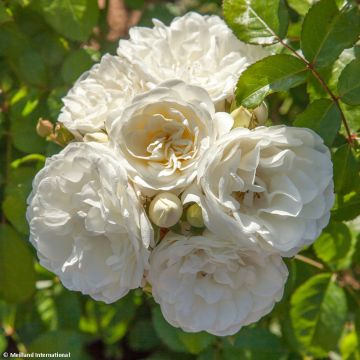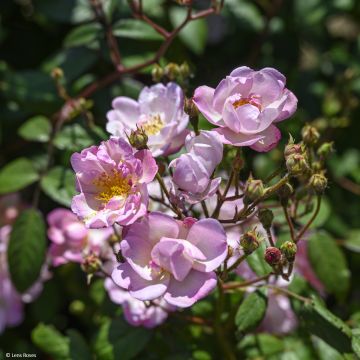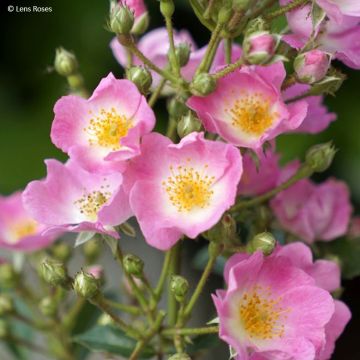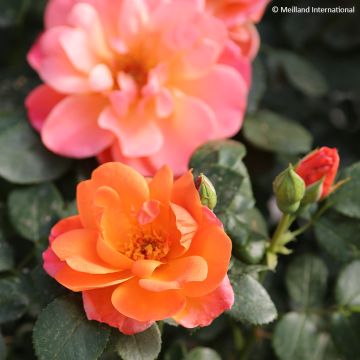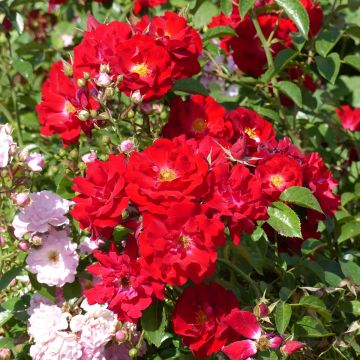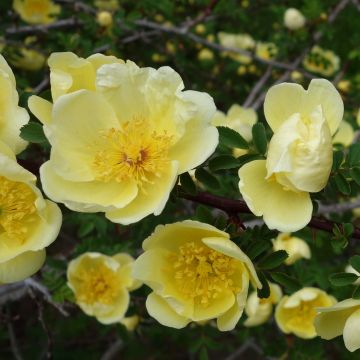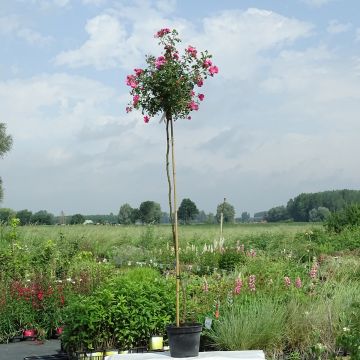

Rosier à fleurs groupées Cherry Bonica Meipeporia
Rosa x polyantha Cherry Bonica
Rosa x polyantha Cherry Bonica 'Meipeporia'
Rose
Thank you to the staff (for order preparation and shipping), the cutting received seems healthy to me. Planted close to the "Scarlet Bonica" variety, I am now patiently waiting for it to take root... or not?
Thierry, 28/08/2024
This item cannot be shipped to the selected country
Delivery charge from €5.90
Delivery charge from €5.90
Delivery charge from €5.90
Delivery charge from €5.90
More information
Schedule delivery date,
and select date in basket
This plant carries a 24 months recovery warranty
More information
We guarantee the quality of our plants for a full growing cycle, and will replace at our expense any plant that fails to recover under normal climatic and planting conditions.
From €5.90 for pickup delivery and €6.90 for home delivery
Express home delivery from €8.90.
From €5.90 for pickup delivery and €6.90 for home delivery
Express home delivery from €8.90.
From €5.90 for pickup delivery and €6.90 for home delivery
Express home delivery from €8.90.
From €5.90 for pickup delivery and €6.90 for home delivery
Express home delivery from €8.90.


Does this plant fit my garden?
Set up your Plantfit profile →
Description
The 'Cherry Bonica' Rose bush is a beautiful red-flowered version of the famous Bonica rose, from which it has inherited exceptional qualities. Just like its parent, this extraordinary landscaping rose bush can withstand anything, it is never sick, tolerates harsh winters as well as hot summers, and provides continuous flowering from early summer until the first frost. Its dense vegetation, adorned with abundant dark green foliage, is dotted with pretty round cup-shaped flowers in a bright pinkish-red colour, grouped in small bouquets. This generous bush deserves a spot in a flower bed, along a path, in a low hedge, on a slope etc. It will not disappoint, whether in the countryside or in the city!
The 'Cherry Bonica' Rose belongs to the group of polyantha roses whose flowers are gathered in terminal clusters. It was introduced in 2014 by Meilland. This exceptional variety has won numerous awards: the German ADR* in 2015, 1st Prize and Public Choice at Paris Bagatelle in 2013, 1st Prize in Lyon in 2013, Gold Medal and Best Urban Landscape Rose Award in Monza (Italy) in 2013. Certificate of Merit Paysage Paris Bagatelle in 2014, Remontance and Resistance Award in Lyon 2014, 1st Prize Baden B. Wien (Austria) in 2014. Environmental Award Orléans in 2015, Gold Medal of the City of Glasgow (Scotland) in 2015, and finally 1st Prize SNHF in 2015.
'Cherry Bonica' has a fairly flexible, compact and dense bushy habit. Its growth is rapid, reaching an average height of 80 cm (32in) with a spread of 60-70 cm (24-28in). If pruned short, this bush behaves like a small polyantha. Its flowering renews itself without interruption from June until the frost. Its flowers are gathered in clusters of 2 to 5 units. They are double, delicately turbinate at first, then open into wide cups of 6-7 cm (2-3in), beautifully crumpled. They bloom from red buds and open into a cherry red or strawberry red colour, fading slightly over time. When faded, they fall off in a shower of petals, leaving the plant always neat. The sturdy stems with scattered thorns of this rose bush carry abundant foliage, a shiny dark green colour, often tinged with bronze on young shoots. This foliage remains beautiful until autumn, staying attached to the branches for a long time before falling.
The extravagant flowering of the Cherry Bonica rose surprises and delights fans of lush gardens without constraints, including those who are new to gardening. It adapts to all soils that are not too dry and to all climates, allowing it to be welcomed without reservation from north to south of our region. It can be planted in groups of 3, arranged in a triangle, or as a solitary plant on a lawn. It will work wonders when planted en masse along a path or to accentuate shrub borders. Create stunning borders by mixing your landscaping roses. It will also fit perfectly in beds of light or opulent perennials. For example, it can be combined with perennial geraniums, catmints, snapdragons, or Stachys. Left to its own devices, its slightly blurry habit will be wildly romantic in front of a flowered shrub border. For example, consider abelias, caryopteris, shrubby salvias etc. It will happily border a large pot on the terrace, balcony, or a flower-filled planter.
ADR is the label of the German Federation of Rose Breeders. The ADR designation is only granted to varieties that have passed the strictest tests in the world. The plants are tested simultaneously in 10 different locations, in various soil and climate conditions for several years. The tests focus on hardiness, perennial character, and flowering without the use of any pesticides.
Report an error about the product description
Rosa x polyantha Cherry Bonica in pictures
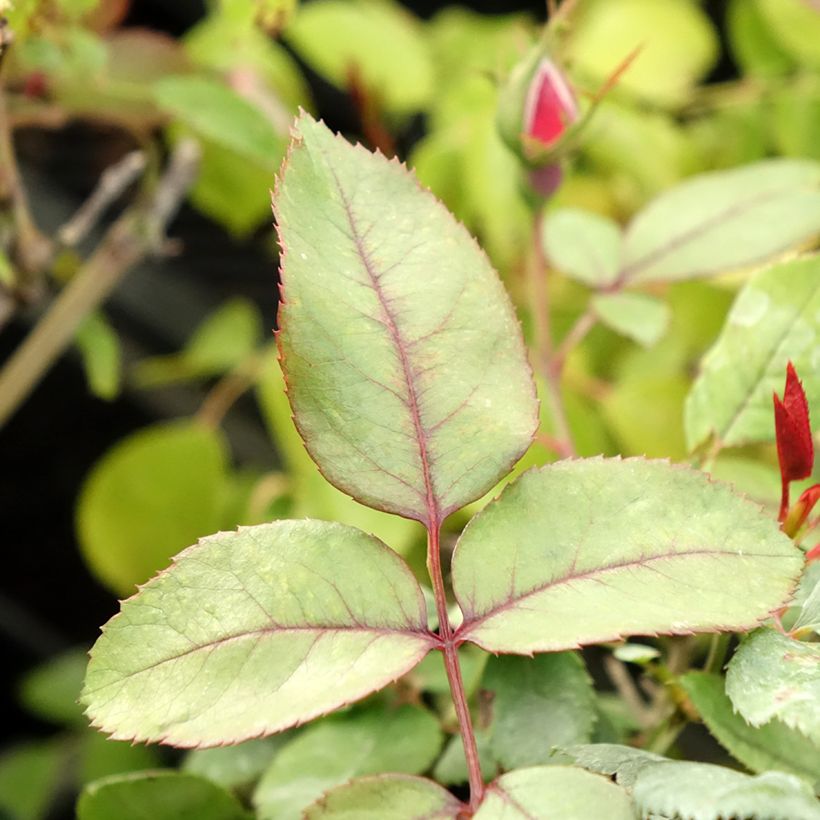

Plant habit
Flowering
Foliage
Botanical data
Rosa
x polyantha
Cherry Bonica 'Meipeporia'
Rosaceae
Rose
Cultivar or hybrid
Other Polyantha clustered Roses
Planting and care
To plant your Cherry Bonica® rose, work the soil to a depth of 25 cubic cm, crumble the soil well and place a base amendment such as dried blood or dehydrated horn at the bottom of the planting hole. Position your plant, removed from its pot, covering the top of the root ball with 3 cm (1in) of soil. Fill in and water generously to eliminate air pockets. In dry weather, it is necessary to water regularly for a few weeks to facilitate rooting. Also remember to provide your rose with special rose fertiliser to stimulate flowering.
Planting period
Intended location
Care
-
, onOrder confirmed
Reply from on Promesse de fleurs
Roses by purpose
Haven't found what you were looking for?
Hardiness is the lowest winter temperature a plant can endure without suffering serious damage or even dying. However, hardiness is affected by location (a sheltered area, such as a patio), protection (winter cover) and soil type (hardiness is improved by well-drained soil).

Photo Sharing Terms & Conditions
In order to encourage gardeners to interact and share their experiences, Promesse de fleurs offers various media enabling content to be uploaded onto its Site - in particular via the ‘Photo sharing’ module.
The User agrees to refrain from:
- Posting any content that is illegal, prejudicial, insulting, racist, inciteful to hatred, revisionist, contrary to public decency, that infringes on privacy or on the privacy rights of third parties, in particular the publicity rights of persons and goods, intellectual property rights, or the right to privacy.
- Submitting content on behalf of a third party;
- Impersonate the identity of a third party and/or publish any personal information about a third party;
In general, the User undertakes to refrain from any unethical behaviour.
All Content (in particular text, comments, files, images, photos, videos, creative works, etc.), which may be subject to property or intellectual property rights, image or other private rights, shall remain the property of the User, subject to the limited rights granted by the terms of the licence granted by Promesse de fleurs as stated below. Users are at liberty to publish or not to publish such Content on the Site, notably via the ‘Photo Sharing’ facility, and accept that this Content shall be made public and freely accessible, notably on the Internet.
Users further acknowledge, undertake to have ,and guarantee that they hold all necessary rights and permissions to publish such material on the Site, in particular with regard to the legislation in force pertaining to any privacy, property, intellectual property, image, or contractual rights, or rights of any other nature. By publishing such Content on the Site, Users acknowledge accepting full liability as publishers of the Content within the meaning of the law, and grant Promesse de fleurs, free of charge, an inclusive, worldwide licence for the said Content for the entire duration of its publication, including all reproduction, representation, up/downloading, displaying, performing, transmission, and storage rights.
Users also grant permission for their name to be linked to the Content and accept that this link may not always be made available.
By engaging in posting material, Users consent to their Content becoming automatically accessible on the Internet, in particular on other sites and/or blogs and/or web pages of the Promesse de fleurs site, including in particular social pages and the Promesse de fleurs catalogue.
Users may secure the removal of entrusted content free of charge by issuing a simple request via our contact form.
The flowering period indicated on our website applies to countries and regions located in USDA zone 8 (France, the United Kingdom, Ireland, the Netherlands, etc.)
It will vary according to where you live:
- In zones 9 to 10 (Italy, Spain, Greece, etc.), flowering will occur about 2 to 4 weeks earlier.
- In zones 6 to 7 (Germany, Poland, Slovenia, and lower mountainous regions), flowering will be delayed by 2 to 3 weeks.
- In zone 5 (Central Europe, Scandinavia), blooming will be delayed by 3 to 5 weeks.
In temperate climates, pruning of spring-flowering shrubs (forsythia, spireas, etc.) should be done just after flowering.
Pruning of summer-flowering shrubs (Indian Lilac, Perovskia, etc.) can be done in winter or spring.
In cold regions as well as with frost-sensitive plants, avoid pruning too early when severe frosts may still occur.
The planting period indicated on our website applies to countries and regions located in USDA zone 8 (France, United Kingdom, Ireland, Netherlands).
It will vary according to where you live:
- In Mediterranean zones (Marseille, Madrid, Milan, etc.), autumn and winter are the best planting periods.
- In continental zones (Strasbourg, Munich, Vienna, etc.), delay planting by 2 to 3 weeks in spring and bring it forward by 2 to 4 weeks in autumn.
- In mountainous regions (the Alps, Pyrenees, Carpathians, etc.), it is best to plant in late spring (May-June) or late summer (August-September).
The harvesting period indicated on our website applies to countries and regions in USDA zone 8 (France, England, Ireland, the Netherlands).
In colder areas (Scandinavia, Poland, Austria...) fruit and vegetable harvests are likely to be delayed by 3-4 weeks.
In warmer areas (Italy, Spain, Greece, etc.), harvesting will probably take place earlier, depending on weather conditions.
The sowing periods indicated on our website apply to countries and regions within USDA Zone 8 (France, UK, Ireland, Netherlands).
In colder areas (Scandinavia, Poland, Austria...), delay any outdoor sowing by 3-4 weeks, or sow under glass.
In warmer climes (Italy, Spain, Greece, etc.), bring outdoor sowing forward by a few weeks.


































